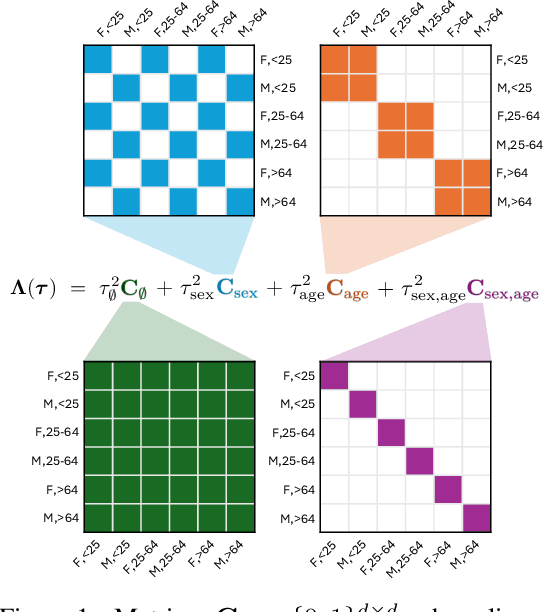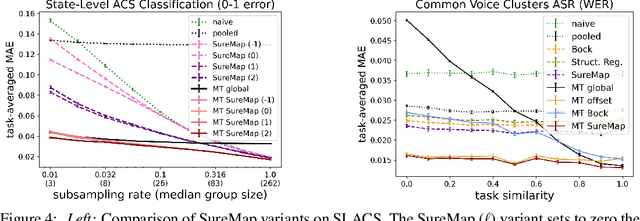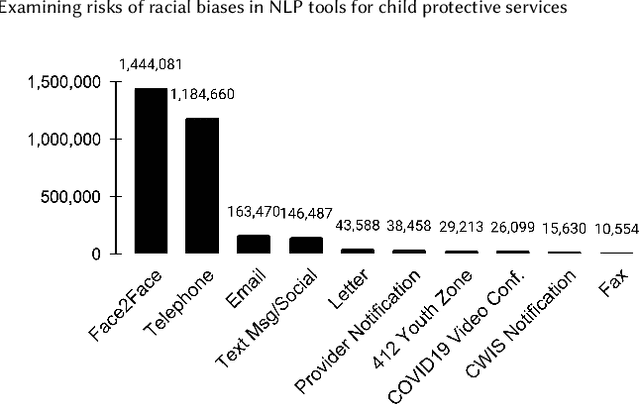Alexandra Chouldechova
Understanding and Meeting Practitioner Needs When Measuring Representational Harms Caused by LLM-Based Systems
Jun 04, 2025Abstract:The NLP research community has made publicly available numerous instruments for measuring representational harms caused by large language model (LLM)-based systems. These instruments have taken the form of datasets, metrics, tools, and more. In this paper, we examine the extent to which such instruments meet the needs of practitioners tasked with evaluating LLM-based systems. Via semi-structured interviews with 12 such practitioners, we find that practitioners are often unable to use publicly available instruments for measuring representational harms. We identify two types of challenges. In some cases, instruments are not useful because they do not meaningfully measure what practitioners seek to measure or are otherwise misaligned with practitioner needs. In other cases, instruments - even useful instruments - are not used by practitioners due to practical and institutional barriers impeding their uptake. Drawing on measurement theory and pragmatic measurement, we provide recommendations for addressing these challenges to better meet practitioner needs.
Taxonomizing Representational Harms using Speech Act Theory
Apr 01, 2025Abstract:Representational harms are widely recognized among fairness-related harms caused by generative language systems. However, their definitions are commonly under-specified. We present a framework, grounded in speech act theory (Austin, 1962), that conceptualizes representational harms caused by generative language systems as the perlocutionary effects (i.e., real-world impacts) of particular types of illocutionary acts (i.e., system behaviors). Building on this argument and drawing on relevant literature from linguistic anthropology and sociolinguistics, we provide new definitions stereotyping, demeaning, and erasure. We then use our framework to develop a granular taxonomy of illocutionary acts that cause representational harms, going beyond the high-level taxonomies presented in previous work. We also discuss the ways that our framework and taxonomy can support the development of valid measurement instruments. Finally, we demonstrate the utility of our framework and taxonomy via a case study that engages with recent conceptual debates about what constitutes a representational harm and how such harms should be measured.
Validating LLM-as-a-Judge Systems in the Absence of Gold Labels
Mar 07, 2025Abstract:The LLM-as-a-judge paradigm, in which a judge LLM system replaces human raters in rating the outputs of other generative AI (GenAI) systems, has come to play a critical role in scaling and standardizing GenAI evaluations. To validate judge systems, evaluators collect multiple human ratings for each item in a validation corpus, and then aggregate the ratings into a single, per-item gold label rating. High agreement rates between these gold labels and judge system ratings are then taken as a sign of good judge system performance. In many cases, however, items or rating criteria may be ambiguous, or there may be principled disagreement among human raters. In such settings, gold labels may not exist for many of the items. In this paper, we introduce a framework for LLM-as-a-judge validation in the absence of gold labels. We present a theoretical analysis drawing connections between different measures of judge system performance under different rating elicitation and aggregation schemes. We also demonstrate empirically that existing validation approaches can select judge systems that are highly suboptimal, performing as much as 34% worse than the systems selected by alternative approaches that we describe. Based on our findings, we provide concrete recommendations for developing more reliable approaches to LLM-as-a-judge validation.
Machine Unlearning Doesn't Do What You Think: Lessons for Generative AI Policy, Research, and Practice
Dec 09, 2024



Abstract:We articulate fundamental mismatches between technical methods for machine unlearning in Generative AI, and documented aspirations for broader impact that these methods could have for law and policy. These aspirations are both numerous and varied, motivated by issues that pertain to privacy, copyright, safety, and more. For example, unlearning is often invoked as a solution for removing the effects of targeted information from a generative-AI model's parameters, e.g., a particular individual's personal data or in-copyright expression of Spiderman that was included in the model's training data. Unlearning is also proposed as a way to prevent a model from generating targeted types of information in its outputs, e.g., generations that closely resemble a particular individual's data or reflect the concept of "Spiderman." Both of these goals--the targeted removal of information from a model and the targeted suppression of information from a model's outputs--present various technical and substantive challenges. We provide a framework for thinking rigorously about these challenges, which enables us to be clear about why unlearning is not a general-purpose solution for circumscribing generative-AI model behavior in service of broader positive impact. We aim for conceptual clarity and to encourage more thoughtful communication among machine learning (ML), law, and policy experts who seek to develop and apply technical methods for compliance with policy objectives.
A Framework for Evaluating LLMs Under Task Indeterminacy
Nov 21, 2024Abstract:Large language model (LLM) evaluations often assume there is a single correct response -- a gold label -- for each item in the evaluation corpus. However, some tasks can be ambiguous -- i.e., they provide insufficient information to identify a unique interpretation -- or vague -- i.e., they do not clearly indicate where to draw the line when making a determination. Both ambiguity and vagueness can cause task indeterminacy -- the condition where some items in the evaluation corpus have more than one correct response. In this paper, we develop a framework for evaluating LLMs under task indeterminacy. Our framework disentangles the relationships between task specification, human ratings, and LLM responses in the LLM evaluation pipeline. Using our framework, we conduct a synthetic experiment showing that evaluations that use the "gold label" assumption underestimate the true performance. We also provide a method for estimating an error-adjusted performance interval given partial knowledge about indeterminate items in the evaluation corpus. We conclude by outlining implications of our work for the research community.
SureMap: Simultaneous Mean Estimation for Single-Task and Multi-Task Disaggregated Evaluation
Nov 14, 2024



Abstract:Disaggregated evaluation -- estimation of performance of a machine learning model on different subpopulations -- is a core task when assessing performance and group-fairness of AI systems. A key challenge is that evaluation data is scarce, and subpopulations arising from intersections of attributes (e.g., race, sex, age) are often tiny. Today, it is common for multiple clients to procure the same AI model from a model developer, and the task of disaggregated evaluation is faced by each customer individually. This gives rise to what we call the multi-task disaggregated evaluation problem, wherein multiple clients seek to conduct a disaggregated evaluation of a given model in their own data setting (task). In this work we develop a disaggregated evaluation method called SureMap that has high estimation accuracy for both multi-task and single-task disaggregated evaluations of blackbox models. SureMap's efficiency gains come from (1) transforming the problem into structured simultaneous Gaussian mean estimation and (2) incorporating external data, e.g., from the AI system creator or from their other clients. Our method combines maximum a posteriori (MAP) estimation using a well-chosen prior together with cross-validation-free tuning via Stein's unbiased risk estimate (SURE). We evaluate SureMap on disaggregated evaluation tasks in multiple domains, observing significant accuracy improvements over several strong competitors.
A structured regression approach for evaluating model performance across intersectional subgroups
Jan 26, 2024



Abstract:Disaggregated evaluation is a central task in AI fairness assessment, with the goal to measure an AI system's performance across different subgroups defined by combinations of demographic or other sensitive attributes. The standard approach is to stratify the evaluation data across subgroups and compute performance metrics separately for each group. However, even for moderately-sized evaluation datasets, sample sizes quickly get small once considering intersectional subgroups, which greatly limits the extent to which intersectional groups are considered in many disaggregated evaluations. In this work, we introduce a structured regression approach to disaggregated evaluation that we demonstrate can yield reliable system performance estimates even for very small subgroups. We also provide corresponding inference strategies for constructing confidence intervals and explore how goodness-of-fit testing can yield insight into the structure of fairness-related harms experienced by intersectional groups. We evaluate our approach on two publicly available datasets, and several variants of semi-synthetic data. The results show that our method is considerably more accurate than the standard approach, especially for small subgroups, and goodness-of-fit testing helps identify the key factors that drive differences in performance.
The Impact of Differential Feature Under-reporting on Algorithmic Fairness
Jan 16, 2024



Abstract:Predictive risk models in the public sector are commonly developed using administrative data that is more complete for subpopulations that more greatly rely on public services. In the United States, for instance, information on health care utilization is routinely available to government agencies for individuals supported by Medicaid and Medicare, but not for the privately insured. Critiques of public sector algorithms have identified such differential feature under-reporting as a driver of disparities in algorithmic decision-making. Yet this form of data bias remains understudied from a technical viewpoint. While prior work has examined the fairness impacts of additive feature noise and features that are clearly marked as missing, the setting of data missingness absent indicators (i.e. differential feature under-reporting) has been lacking in research attention. In this work, we present an analytically tractable model of differential feature under-reporting which we then use to characterize the impact of this kind of data bias on algorithmic fairness. We demonstrate how standard missing data methods typically fail to mitigate bias in this setting, and propose a new set of methods specifically tailored to differential feature under-reporting. Our results show that, in real world data settings, under-reporting typically leads to increasing disparities. The proposed solution methods show success in mitigating increases in unfairness.
Multi-Target Multiplicity: Flexibility and Fairness in Target Specification under Resource Constraints
Jun 23, 2023



Abstract:Prediction models have been widely adopted as the basis for decision-making in domains as diverse as employment, education, lending, and health. Yet, few real world problems readily present themselves as precisely formulated prediction tasks. In particular, there are often many reasonable target variable options. Prior work has argued that this is an important and sometimes underappreciated choice, and has also shown that target choice can have a significant impact on the fairness of the resulting model. However, the existing literature does not offer a formal framework for characterizing the extent to which target choice matters in a particular task. Our work fills this gap by drawing connections between the problem of target choice and recent work on predictive multiplicity. Specifically, we introduce a conceptual and computational framework for assessing how the choice of target affects individuals' outcomes and selection rate disparities across groups. We call this multi-target multiplicity. Along the way, we refine the study of single-target multiplicity by introducing notions of multiplicity that respect resource constraints -- a feature of many real-world tasks that is not captured by existing notions of predictive multiplicity. We apply our methods on a healthcare dataset, and show that the level of multiplicity that stems from target variable choice can be greater than that stemming from nearly-optimal models of a single target.
* Conference on Fairness, Accountability, and Transparency (FAccT '23), June 12-15, 2023, Chicago, IL, USA
Examining risks of racial biases in NLP tools for child protective services
May 30, 2023



Abstract:Although much literature has established the presence of demographic bias in natural language processing (NLP) models, most work relies on curated bias metrics that may not be reflective of real-world applications. At the same time, practitioners are increasingly using algorithmic tools in high-stakes settings, with particular recent interest in NLP. In this work, we focus on one such setting: child protective services (CPS). CPS workers often write copious free-form text notes about families they are working with, and CPS agencies are actively seeking to deploy NLP models to leverage these data. Given well-established racial bias in this setting, we investigate possible ways deployed NLP is liable to increase racial disparities. We specifically examine word statistics within notes and algorithmic fairness in risk prediction, coreference resolution, and named entity recognition (NER). We document consistent algorithmic unfairness in NER models, possible algorithmic unfairness in coreference resolution models, and little evidence of exacerbated racial bias in risk prediction. While there is existing pronounced criticism of risk prediction, our results expose previously undocumented risks of racial bias in realistic information extraction systems, highlighting potential concerns in deploying them, even though they may appear more benign. Our work serves as a rare realistic examination of NLP algorithmic fairness in a potential deployed setting and a timely investigation of a specific risk associated with deploying NLP in CPS settings.
 Add to Chrome
Add to Chrome Add to Firefox
Add to Firefox Add to Edge
Add to Edge